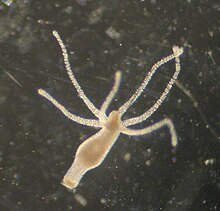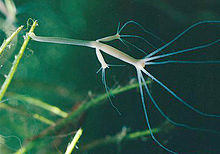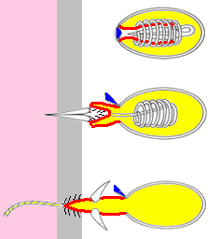Freshwater polyps
| Freshwater polyps | ||||||||||||
|---|---|---|---|---|---|---|---|---|---|---|---|---|

|
||||||||||||
| Systematics | ||||||||||||
|
||||||||||||
| Scientific name of the family | ||||||||||||
| Hydridae | ||||||||||||
| Dana , 1846 | ||||||||||||
| Scientific name of the genus | ||||||||||||
| Hydra | ||||||||||||
| Linnaeus , 1758 |
Freshwater polyps ( Hydra ) are a genus from the class of Hydrozoa (Hydrozoa), which belong to the tribe of the cnidarians (Cnidaria). Freshwater polyps can grow up to 3 cm in size, depending on the species, and colonize fresh and flowing water, and in exceptional cases also brackish water . Hydra is - if Chlorohydra is not counted as a separate genus, as some authors do, the only genus within the Hydridae family .
In Europe at least 5 species of the genus are found, including Hydra vulgaris (Common anemone) and Hydra viridissima (also Chlorohydra viridissima called Hydra or green, the green coloring occurs because with Hydra symbiotically living Chlorella -Algen ago). Hydra is sometimes found in aquariums and is often only noticed when it multiplies violently due to increased food supply.
Characteristic
The representatives of the genus and family live as solitary polyps ; no medusa stages and also no gonophores , as they are common with other hydrozoans, are formed. Hydra have a ring of hollow filiform tentacles around the mouth cone. The lower part of the polyp has a foot disk. Sexual and asexual reproduction occurs. The sex products develop directly in wart-like protrusions in the epidermis of the polyp, the male in the upper part of the polyp, the female in the lower part. Asexual reproduction occurs through budding, longitudinal or transverse division. Fertilized eggs can be covered with a protective cover and last a long time before the small polyp hatches. There are four types of nettle cells : stenotles, desmonemas, atric and holotric isorhizas.
anatomy
The body wall of the freshwater polyp or hydra consists of three layers: the "outer skin" ( ectodermal epidermis ), the "inner skin" ( endodermal gastrodermis ) and a gelatinous support matrix, the so-called mesogloea , which apart from nerve cells is cell-free. Ectoderm and endoderm are each made up of cells. In the ectoderm there are sensory or receptor cells that absorb environmental stimuli such as light currents of water or chemical stimuli and pass the information on to nerve cells in the supporting layer via an extension.
In addition, there are nettle capsules (cnidia) in the ectoderm , which are ejected, release a paralyzing poison and thus serve to catch prey. These nettle capsules cannot be regenerated, so they can only be ejected once. They are formed by nettle cells (cnidoblasts), which in turn arise from so-called interstitial cells. Cnidoblasts and interstitial cells have in common that several individual cells are connected by intercellular bridges. In Hydra, nettle capsules appear in clusters on the tentacles. 2500 to 3500 nettle capsules are attached to each of these tentacles.
However, the largest proportion of the cells of the ectoderm form epithelial muscle cells , which are attached to the supporting layer with a basal process in which there are muscle filaments . The epithelial muscle cells form longitudinal muscle layers along the polyp body. By stimulating these cells, the polyp can contract quickly. Muscle cells are also located in the endoderm; because of their function, the absorption of nutrients, these are called nutrient muscle cells . In contrast to the muscle cells of the ectoderm, they are arranged in a ring. This causes the polyp to stretch as the muscle cells of the endoderm contract.
The endodermal gastrodermis encloses a cavity, the so-called gastrocoel or coelenteron . Since this cavity takes on the tasks of a digestive tract as well as a vascular system, it is referred to as a gastrovascular system . For this purpose, in addition to the nutritional muscle cells in the endoderm, there are also specialized gland cells that secrete digestive secretions.
In addition, there are replacement cells in both the ectoderm and the endoderm that can transform into other cells or produce, for example, sperm and egg cells (most polyps are hermaphrodites).
Nervous system
The Hydra has like all Hohltiere (coelenterates) is a network of nerves on. There are no coordination centers such as ganglia or a brain . Nevertheless, an accumulation of sensory and nerve cells and their appendages on the mouth and stem can be observed. Freshwater polyps react to chemical, mechanical and electrical stimuli, as well as to light and temperature.
Food intake and digestion
The diet of freshwater polyps consists of small crabs, water fleas , larvae of insects , water mites , plankton and other small animals in the water. They are caught with the help of the tentacles . If an animal touches a tentacle, it gets stuck there and is paralyzed, possibly even killed, by the poison of the shot out nettle capsules. The nettle capsules have a small appendage which, when touched, opens a tiny lid; the tube of the nettle capsule pops out, penetrating the victim, releasing its poison, paralyzing it. The process of popping out only takes about 3 microseconds. Then the tentacles bend and move the prey towards the mouth opening. From there it reaches the gastrovascular tract of the polyp, where it is digested by a secretion from the gland cells and absorbed by nutrient muscle cells (endocytosis). Indigestible food is finally excreted through the mouth opening.
Locomotion
Polyps can move like caterpillars and by "rollover". In the first case, the trunk is tilted to one side until the mouth field with the tentacles touches the ground. There they attach themselves for a short time with the help of glutinants (a type of nettle capsule with sticky secretions). The lower end of the torso is then pulled along and the body stretched out to the side again. When moving by rolling over, the animal also attaches the tentacles to the ground, but moves the trunk from one side to the other and straightens up again. Polyps migrate about 2 cm per day. Hydra can also move upwards in the water by forming a gas bubble on the foot gland that provides buoyancy.
Reproduction and Life Expectancy
In contrast to most other cnidarians, freshwater polyps lack the medusa generation , they only occur in the form of polyps and do not show a generation change (metagenesis). Hydra can reproduce asexually, in the form of sprouting new polyps on the stalk of the parent polyp, through longitudinal and transverse division, and under certain circumstances sexually. These circumstances have not yet been fully clarified, but lack of food plays a major role. The animals can be male, female or also hermaphrodite. Sexual reproduction is initiated by the formation of sex cells in the animal's wall. Characteristic sperm-filled protrusions ("testicles") form in the upper third of the animal and an ovary with a large egg cell in the lower third of a hermaphrodite animal. The eggs are still fertilized in the epidermal wall. The fertilized egg is either actively attached to the ground by the animal or passively sinks to the ground. However, it can also surround itself with a periderm cover and last for months in this form. In this form, it survives drying out and freezing through. Then a small polyp slips out of the peridermal cover.
With polyps, the risk of death does not increase with age. Under ideal conditions, it has a life expectancy of several centuries.
regeneration
The freshwater polyps have a remarkable ability to regenerate . Instead of repairing damaged cells , they are constantly being replaced as stem cells divide and sometimes differentiate. A freshwater polyp renews itself practically completely within five days. The ability to even replace nerve cells has so far been considered unique in the animal kingdom. It should be noted, however, that the nerve cells of freshwater polyps are very primitive types of neurons. Some populations that have been under observation for long periods have shown no signs of aging . Under constant optimal environmental conditions, the age of a freshwater polyp may not be limited. In 2012, researchers from Christian-Albrechts-Universität zu Kiel (CAU) described the transcription factor FOXO3, discovered in Hydra in 2010, as a critical factor in the regulation of stem cell proliferation . A gene product that is also found in vertebrates and humans. This suggests that mechanisms that control longevity are evolutionarily conserved.
Another special property of freshwater polyps is that when their cells are separated from one another, they find each other again or new polyps grow out of them. A new individual can grow from single pieces of 1/200 the mass of an adult polyp. For example, a freshwater polyp that has been pushed through a net can reassemble itself. This property is of great interest for biotechnology .
Research history
Freshwater polyps were scientifically described for the first time as early as 1702; they have been scientifically studied for 300 years. Experimental studies between 1736 and 1744 culminated in the discovery of asexual reproduction by budding and the first description of regeneration processes in an animal. It was Abraham Trembley who mainly dealt with freshwater polyps (Hydra). He was the first to not only observe and describe animals, but also to carry out targeted experiments. Therefore, in the opinion of some leading figures, he has the rank of father of experimental zoology.
Researchers at the Christian-Albrechts-Universität in Kiel have discovered that the freshwater polyp Hydra magnipapillata produces a protein called hydramacin-1 , which literally clumps and kills a number of bacteria. They also succeeded in isolating the associated gene so that they could produce the protein in its pure form. They found that hydramacin-1 can kill enterobacteria , klebsiae , streptococci and yersinia even in relatively small doses . However, it was less effective against some other germs, such as Staphylococcus aureus .
The complete genome of Hydra magnipapillata has been sequenced since 2009.
Freshwater polyps as environmental indicators
Freshwater polyps tolerate only low concentrations of heavy metals , such as cadmium , and other pollutants in their environment, which is why they are used as indicators of water pollution.
Systematics
The family Hydridae is placed in the "World Hydrozoa Database" in the suborder Capitata of the Anthomedusae . Jean Bouillon et al. (2006) place them in a suborder Moerisiida Poche, 1914 (together with the families Boeromedusidae , Halimedusidae , Moerisiidae and Polyorchidae ). This position of the Hydridae is in turn by Allen et al. (2004) decidedly rejected due to molecular biological data. These authors combine the family Hydridae with Candelabridae, Corymorphidae and Tubulariidae in a taxon Aplanulata (without hierarchical rank). The works list a total of 33 species of the genus Hydra . Some authors place the species hadleyi and viridissima in a separate genus Chlorohydra within the family of the Hydridae.
|
|
|
supporting documents
literature
- Jean Bouillon, Cinzia Gravili, Francesc Pagès, Josep-Maria Gili and Fernando Boero: An introduction to Hydrozoa. Mémoires du Muséum national d 'Histoire naturelle, 194: 1-, Publications Scientifiques du Muséum, Paris 2006, ISBN 978-2-85653-580-6 .
- Marymegan Daly, Mercer R. Brugler, Paulyn Cartwright, Allen G. Collin, Michael N. Dawson, Daphne G. Fautin, Scott C. France, Catherine S. McFadden, Dennis M. Opresko, Estefania Rodriguez, Sandra L. Romano & Joel L. Stake: The phylum Cnidaria: A review of phylogenetic patterns and diversity 300 years after Linnaeus. Zootaxa, 1668: 127-182, Wellington 2007 ISSN 1175-5326 Abstract - PDF .
- Allen G. Collins, Silke Winkelmann, Heike Hadrys and Bernd Schierwater: Phylogeny of Capitata (Cnidaria, Hydrozoa) and Corynidae (Capitata) in light of mitochondrial 16S rDNA data. Zoologica Scripta, 34: 91-99, 2004 doi : 10.1111 / j.1463-6409.2005.00172.x .
Volker Storch, Ulrich Welsch, Adolf Remane: Systematic Zoology. 6th edition. Spectrum Academic Publishing House, 2003, ISBN 3-8274-1112-2 .
On-line
Individual evidence
- ^ Marianne Klug, Jakob Weber and Pierre Tardent: Hemolytic and toxic properties of Hydra attenuata nematocysts. Toxicon , 27 (3): 325-339, Oxford 1989 doi : 10.1016 / 0041-0101 (89) 90180-3
- ^ Max Planck Society : A Touch of Immortality , dated December 8, 2015, loaded on September 23, 2016
- ↑ DE Martinez: Mortality patterns suggest lack of senescence in hydra. In: Exp Gerontol 33, 1998, pp. 217-225. PMID 9615920
- ↑ FOCUS Online: "Has the secret of eternal youth been revealed ?: German researchers discover the immortality gene" - http://www.focus.de/gesundheit/news/ist-das-geheimnis-ewiger-jugend-gelueftet-deutsche-forscher -discover-immortality-gene-in-suesswassertierchen_aid_861836.html
- ↑ Abraham Trembley. The Embryo Project. Arizona State University
- ↑ Sascha Jung: The elucidation of the tertiary structure of the antimicrobial peptide Hydramacin-1 with the help of multi-dimensional heteronuclear NMR spectroscopy and the investigation of its mechanism of action. Dissertation, Christian Albrechts University - Faculty of Mathematics and Natural Sciences, Kiel 2008 ( PDF file ).
- ^ Sascha Jung, Andrew J. Dingley, René Augustin et al .: Activity of a Protein from the Basal Metazoan Hydra. In: Journal of Biological Chemistry. Vol. 284, No. 3, pp. 1896-905, doi : 10.1074 / jbc.M804713200 ( full text online ).
- ↑ Thomas CG Boscha, René Augustin, Friederike Anton-Erxleben et al .: Uncovering the evolutionary history of innate immunity: The simple metazoan Hydra uses epithelial cells for host defense. In: Developmental & Comparative Immunology. April 2009, Vol. 33, No. 4, pp. 559-569, doi : 10.1016 / j.dci.2008.10.004 .
- ^ Jarrod A. Chapman et al .: The dynamic genome of Hydra . In: Nature . March 25, 2010, No. 464, pp. 592–596 Letter, doi : 10.1038 / nature08830 .
- ↑ [1]
- ^ Entry Hydridae at ITIS
Web links
- The freshwater polyp (Greek hydra )
- World Register of Marine Species
- The "monster" Hydra sp. - even Hercules could not conquer it alone
- Observation of freshwater polyps
- "Unloading the Stenotelen bei Hydra attenuata (Cnidaria, Hydrozoa)" (1988) - science film from the collection of the Federal Institute for Scientific Film (ÖWF) in the online archive of the Austrian Media Library


